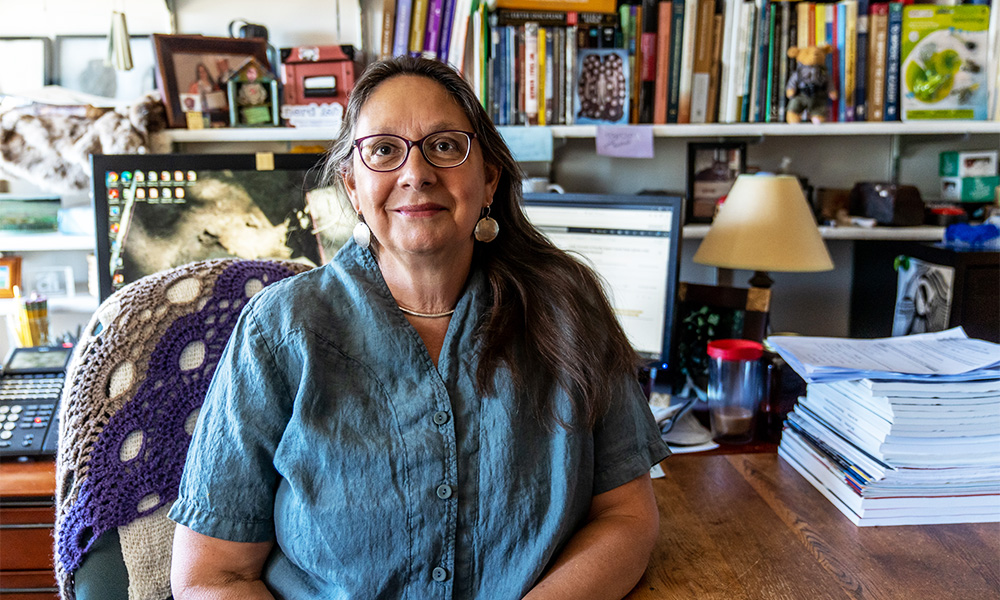Q and A with JMU's Dr. Carole Nash
JMU Headlines
SUMMARY: Dr. Carole Nash (’83) was recently appointed by Virginia Gov. Glenn Youngkin to the board of trustees of the Virginia Museum of Natural History.
Dr. Carole Nash (’83), a professor in the School of Integrated Sciences, was recently appointed by Virginia Gov. Glenn Youngkin to the board of trustees of the Virginia Museum of Natural History.
A double Duke, Nash began her teaching career in 1989 and has more than 40 years of experience in cultural resource management. She is also passionate about promoting cultural heritage through education and citizen science, which makes her an ideal fit for this role.
University Communications recently spoke with Dr. Nash to talk about her current and upcoming work with the museum.
Q: What was your reaction to being appointed to the board of trustees for the Virginia Museum of Natural History?
I am very pleased to be reappointed by Gov. Youngkin. My first term as trustee was filled with learning about the museum’s operations and goals, and I’m glad to have the opportunity to apply that knowledge as the board makes decisions about the museum's future. My expertise in archaeology allows me to contribute to that segment of the museum's work. I am especially excited about the planning for the new museum campus in Waynesboro, which we hope will start construction in the next few years.
Q: What is your role on the board?
As trustee, I provide oversight for museum operations. The board evaluates the director and works with him as his duties evolve. For example, the museum recently submitted a self-study for reaccreditation with the American Alliance of Museums, and the board provided review and comments on that process. I also serve on two committees: Research and Collections and Waynesboro Advocacy.
Q: Do you have any previous experience on a board?
This is a reappointment to the board, and I had an earlier gubernatorial appointment to the Virginia Council on Indians. I serve on several nonprofit boards and am president of one — Mountain Valley Archaeology.
Q: Do you have any previous professional connection to the museum?
Yes, I have been a research associate with the museum since 2000.
Q: What connections does JMU have with the museum?
Dr. Tom Benzing, Integrated Science and Technology (ret.), served on the board for two terms and is also a research affiliate. Faculty from JMU, especially in the College of Science and Mathematics, have contributed collections and undertaken research with the Virginia Museum of Natural History. Dr. Scott Eaton (Geology and Environmental Science) and Dr. Christine May (Biology) are helping advise the development of exhibits for the planned Waynesboro campus.
Q: What are some initiatives and projects the board will undertake during your term?
The construction of the new Waynesboro campus, which includes exhibit space, children’s areas, a research laboratory, classrooms, and patio and gift shop will happen during my second term. Located on the South River at the foot of the Blue Ridge, the museum will focus on the natural history of the Shenandoah Valley and provide visitors with learning experiences that focus on our unique region. Currently, the Mobile Science Unit containing exhibits is located on the site to keep the community informed. The main campus in Martinsville continues to grow its programming in educational outreach and research, with new curators in herpetology and invertebrates. Construction on a new education pavilion is underway.
Q: Why is it important for us to learn about Virginia’s natural heritage?
Natural history is a gateway to understanding our own history and identity, as it provides an understanding of the environmental processes that have shaped our world, as well as our responsibility to care for our planet. Natural history is the context for human history, and the more we know about the systems — both living and nonliving — that surround us, the better decisions we can make for our care for them. Virginia, with its biodiversity, varied topographic settings (from coast to mountains), watersheds that drain to the Atlantic and Gulf of Mexico, and so on, is a huge learning laboratory that enables us to appreciate the complexity and beauty of nature. Indigenous communities have known this for millennia. Being trained as an environmental anthropologist, I see strong connections between the well-being of humans and nature. Finally, knowledge of natural history is more important now than ever as we experience the challenges of climate change and acknowledge the stresses that we have placed on natural systems. That knowledge is a catalyst for action.
